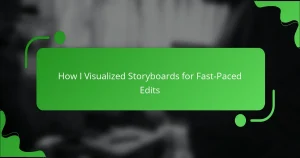Key takeaways
- Set design significantly influences the narrative and emotional engagement in films, particularly in action genres like “Mad Max.”
- Key elements such as authenticity, color palette, and spatial dynamics are essential in creating immersive environments that reflect themes and character struggles.
- Utilizing salvaged materials and muted color schemes can enhance storytelling, making the visual narrative more impactful and relatable.
- Thoughtful design choices not only elevate action scenes but also deepen audience investment in the characters’ journeys.
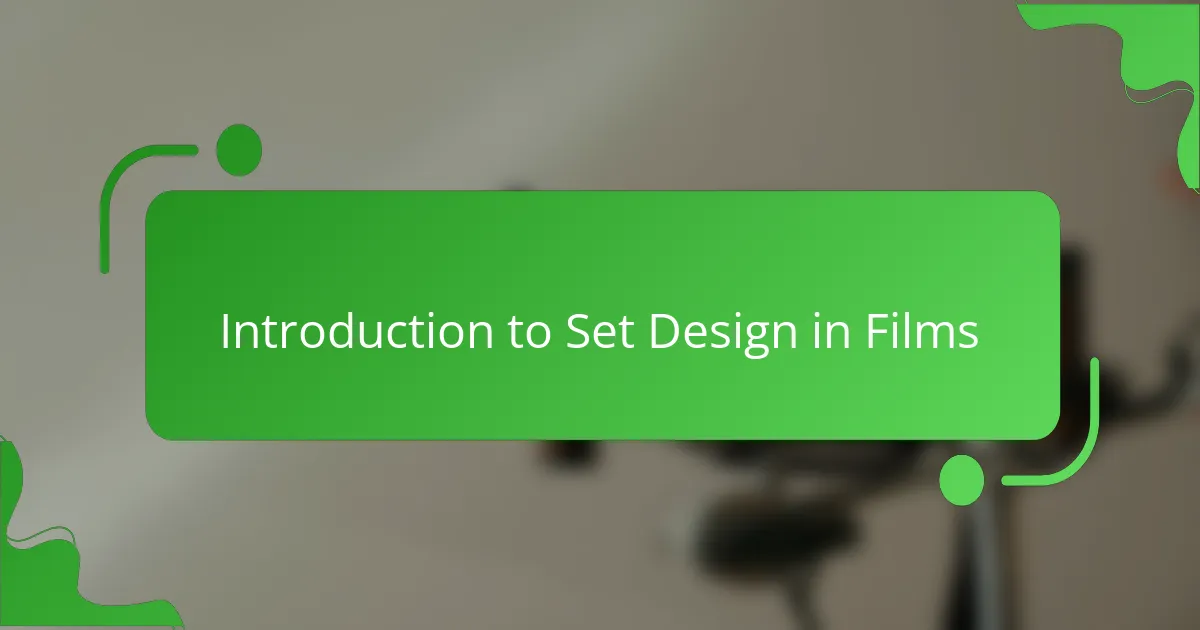
Introduction to Set Design in Films
Set design in films plays a crucial role in shaping the overall narrative and immersing the audience into the story’s world. When it comes to films like “Mad Max,” the set design isn’t just about aesthetics; it enhances the emotional impact and reflects the chaotic themes of survival and dystopia. I’ve always found that when a set is meticulously crafted, it draws me in, making me feel as if I’m part of that rugged universe.
As I reflect on various action films, I notice that the set design can significantly influence how we perceive characters and their journeys. The gritty landscapes and makeshift vehicles in “Mad Max” evoke a sense of desperation and resilience. This kind of environment doesn’t just serve the plot—it becomes a character in its own right, setting the tone and enhancing the storytelling.
Here’s a quick comparison highlighting some elements of set design related to “Mad Max” and other action films:
| Element | Mad Max | Typical Action Film |
|---|---|---|
| Theme | Dystopia and Survival | Heroic Undertones |
| Materials Used | Salvaged and Rigid | Sleek and Polished |
| Color Palette | Desaturated and Earthy | Vibrant and Bold |
| Emotional Impact | Raw and Unsettling | Inspiring and Aspirational |
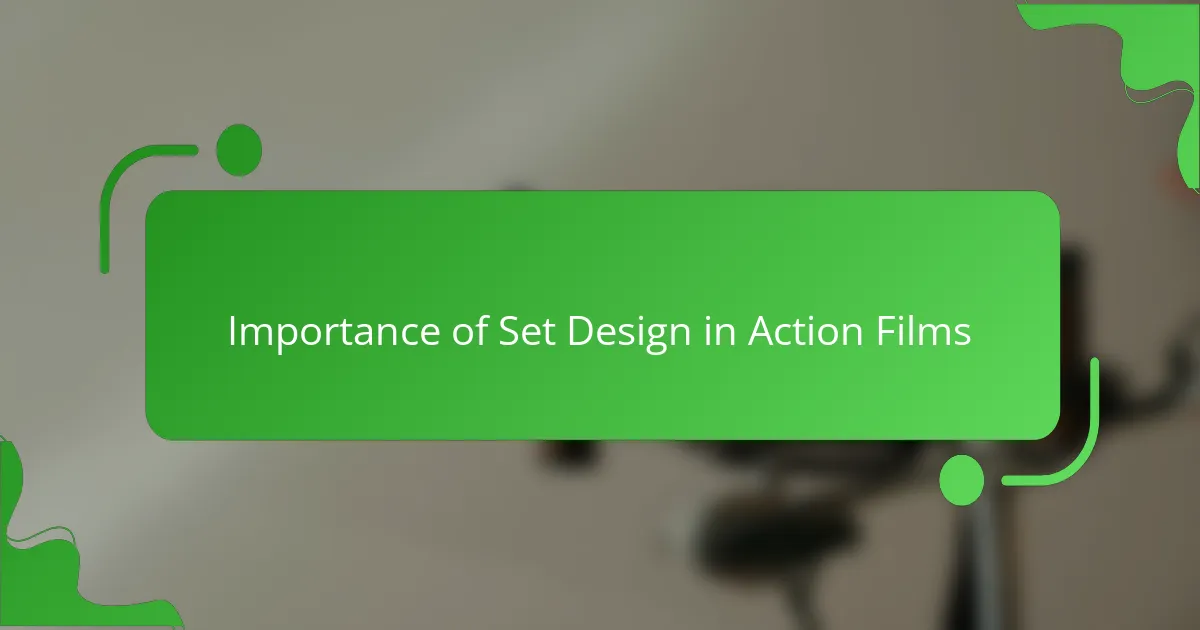
Importance of Set Design in Action Films
Set design is crucial in action films, as it creates immersive worlds that draw viewers into the narrative. I remember watching “Mad Max: Fury Road” and being struck by how the desolate landscapes and makeshift structures reflected the chaos of that universe. It’s this kind of setting that not only supports the action but elevates the emotional stakes for the characters we care about.
A well-crafted set can also enhance storytelling by visually communicating themes and character motivations. Think about how the rusting vehicles and barren wastelands in “Mad Max” convey a sense of desperation and survival. Every detail in the set tells a story, making the experience richer for the audience.
- Establishes Tone: The environment sets the overall mood, influencing how the audience feels.
- Supports Characters: A character’s background can be visually represented through their surroundings.
- Enhances Action: Thoughtful design creates dynamic settings that elevate fight scenes and chase sequences.
- Symbols: Elements of the set can symbolize larger themes, deepening the narrative.
- Engagement: A visually stunning environment keeps viewers invested in the story.
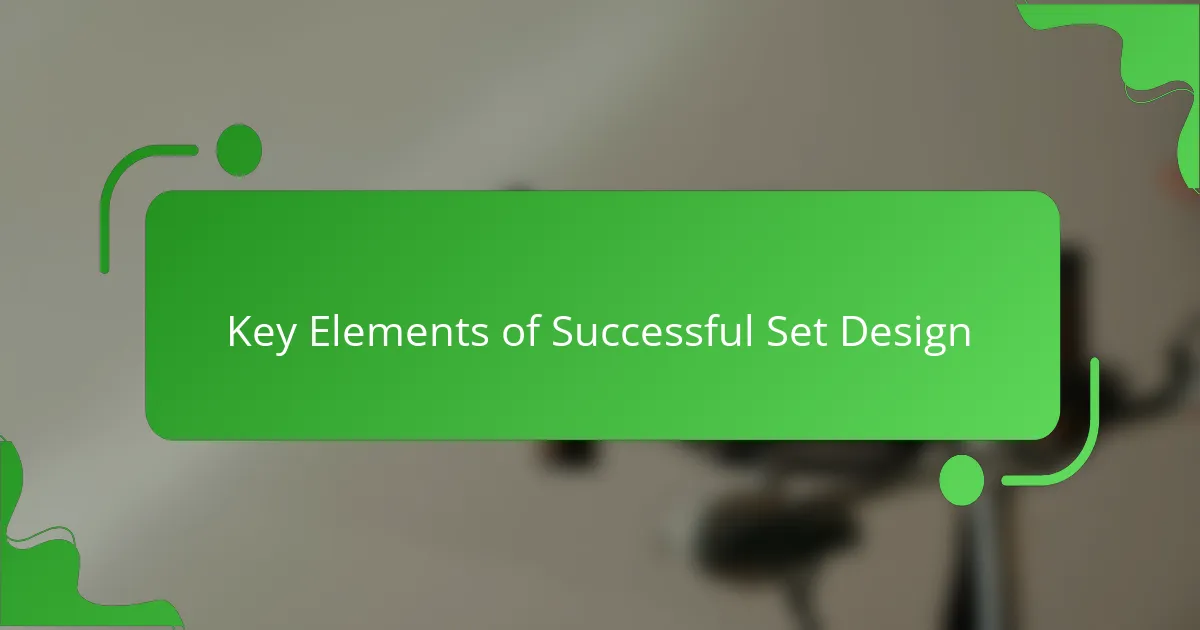
Key Elements of Successful Set Design
When I think about what makes set design really successful, one key element stands out: authenticity. In “Mad Max,” the grunge and wear of the sets genuinely reflect the harsh realities of the world they inhabit. I remember feeling unnerved yet captivated by the rusty vehicles and makeshift structures that seemed to pulse with a life of their own. Isn’t it fascinating how such gritty details can make us believe in a fictional universe so deeply?
Color is another vital factor in set design. The desaturated, earthy tones in “Mad Max” evoke a sense of desolation that resonates with the film’s themes of survival and chaos. Each hue feels intentional, drawing me into an emotional state that perfectly complements the storyline. I often find myself asking: how would a vibrant color palette change my experience of a film? It could easily shift my perception from one of desperation to something more heroic, changing my emotional connection with the characters.
Lastly, I believe that spatial dynamics play a crucial role in set design success. In action films, the way spaces are arranged can affect not just the visual aesthetic but the tension of a scene. For example, the vast, open wastelands in “Mad Max” serve to highlight the isolation felt by the characters. Watching those expansive shots left me feeling small and vulnerable. Isn’t it incredible how a well-thought-out design can impact not just our understanding of the story but also our emotional engagement with it?
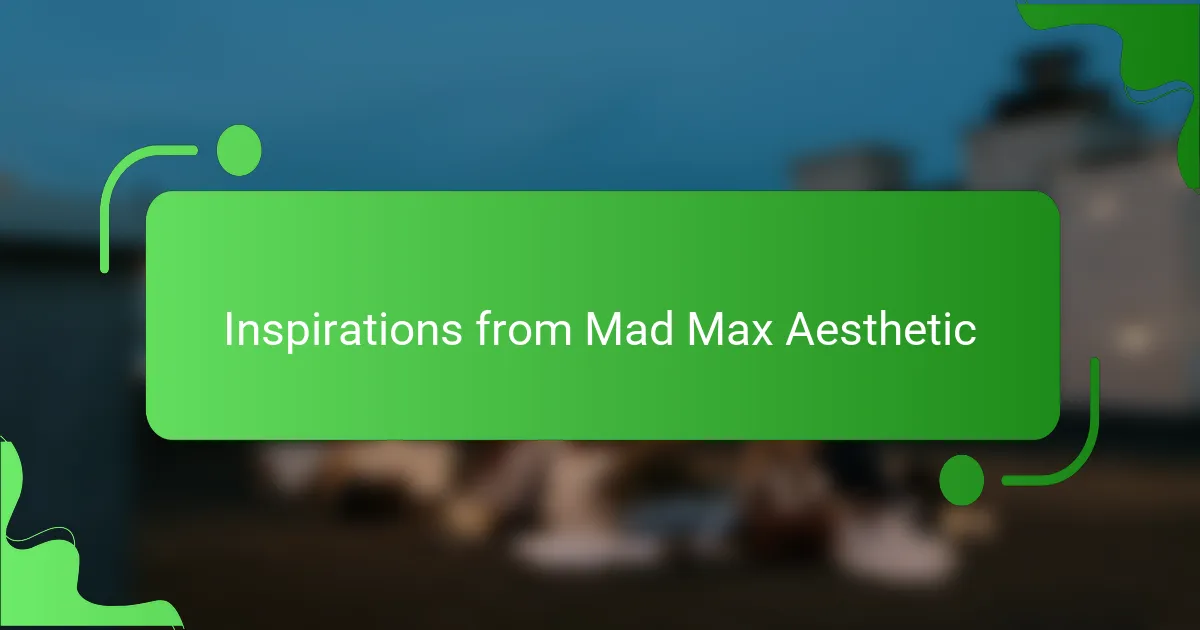
Inspirations from Mad Max Aesthetic
When I think about the Mad Max aesthetic, I’m struck by its raw intensity and dystopian charm. The way desolation marries creativity is utterly captivating. The element of scavenging—transforming waste into something functional—resonates with me as a set designer. It challenges me to look at everyday objects differently, turning the ordinary into extraordinary.
The vast, barren landscapes create a sense of isolation that amplifies the chaos of the characters’ struggles. Each set piece, from rusted vehicles to crumbling civilizations, tells a story of resilience and survival. It’s a powerful reminder that, in a world driven by destruction, beauty can still emerge from hardship, inspiring my own work to reflect that duality.
- The use of repurposed materials enhances the story’s authenticity.
- Bold color palettes, like rust and sand, evoke emotions of despair and hope.
- Unique vehicle designs serve as character extensions, showcasing individuality.
- The contrast between civilization and wasteland highlights the stakes for the characters.
- Lighting choices create tension and emphasize the gritty atmosphere.
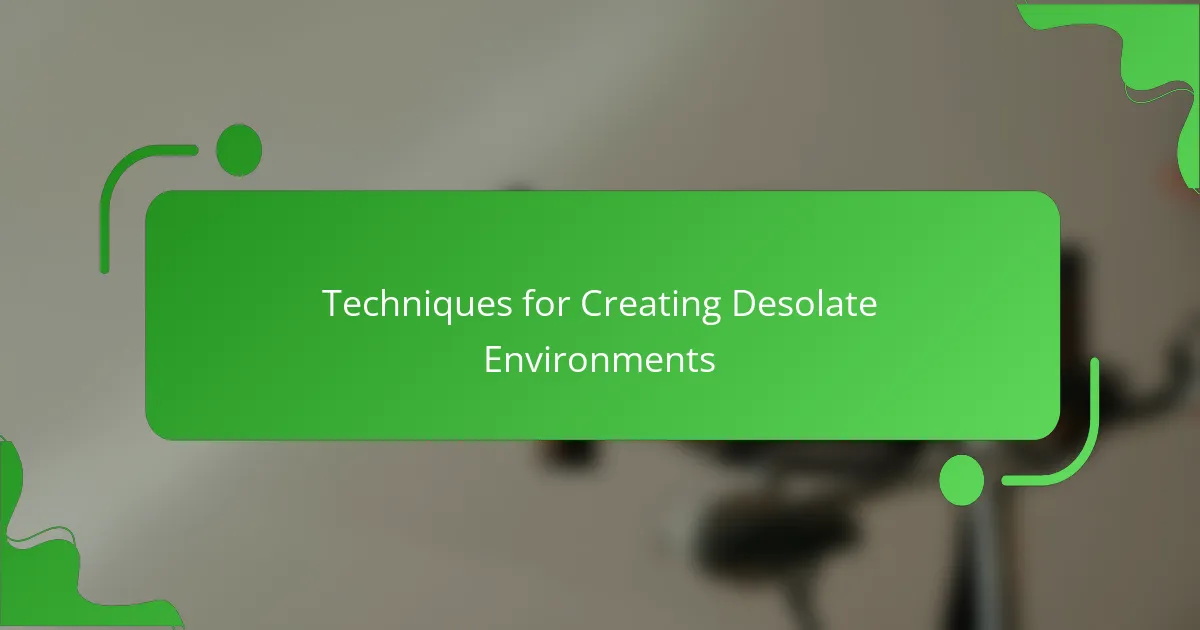
Techniques for Creating Desolate Environments
Creating desolate environments is an art form that requires careful thought and creativity. When I worked on a short film inspired by the barren landscapes of “Mad Max,” I learned that the use of color palettes can significantly influence the mood. Dusty earth tones, paired with stark contrasts, evoke a sense of isolation and danger, making the viewer feel the harshness of the world the characters inhabit.
In addition to the right colors, the arrangement of various elements in the scene plays a crucial role. I remember building a makeshift wasteland out of discarded materials, where each piece told a story of its own. This type of setting isn’t just about emptiness; it invites viewers to engage with the narrative deeply, evoking feelings of despair or courage amidst chaos.
- Use muted color palettes with browns, grays, and deep reds.
- Incorporate recycled or discarded materials to build your set.
- Create asymmetry in the layout to enhance feelings of discomfort.
- Add layers of texture through rusted metal and cracked surfaces.
- Use strategic lighting to cast haunting shadows and emphasize isolation.
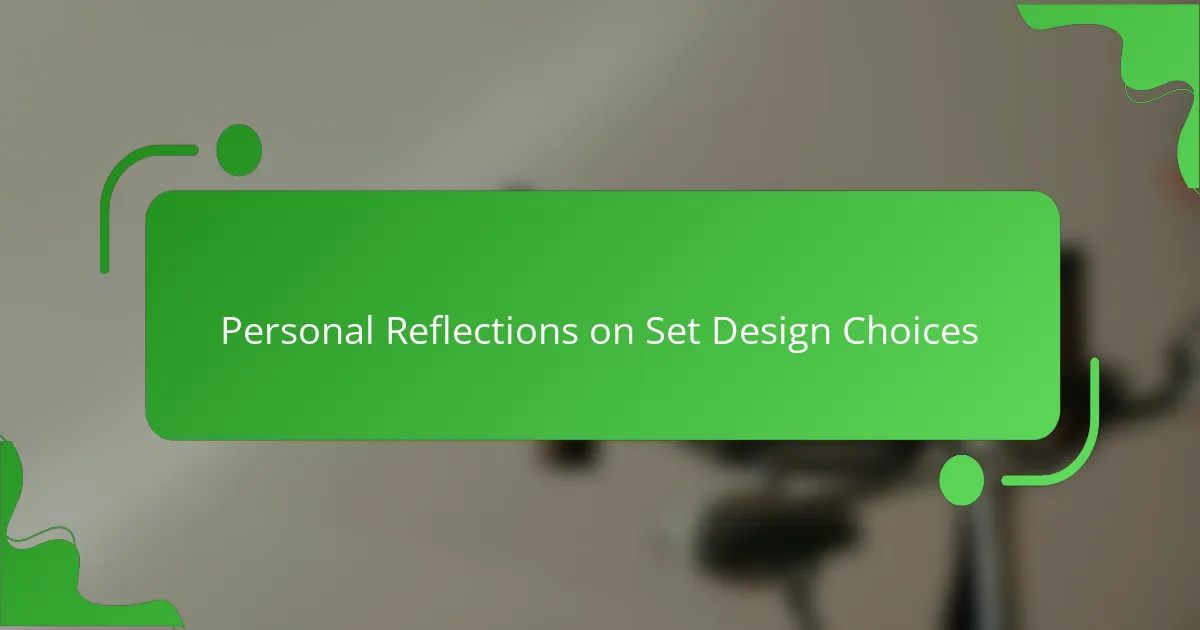
Personal Reflections on Set Design Choices
When I think about set design in the Mad Max universe, I can’t help but feel a rush of adrenaline. The gritty, post-apocalyptic landscapes are not just backgrounds; they tell a story of survival and resilience. I remember watching Mad Max: Fury Road for the first time, and I was instantly transported into a world where every piece of set design—from the rusting vehicles to the vast desert expanses—spoke volumes about the characters’ struggles.
What strikes me most is how the color palettes and textures evoke emotions. For instance, the stark contrasts between the dull browns of the wasteland and the bright splashes of color in the War Boys’ vehicles create a chaotic yet captivating aesthetic. This kind of intentional design can significantly shape the viewer’s experience in action short films. Here are some thoughts inspired by these choices:
- Storytelling through Environment: Every rusted car and cracked surface can reflect the narrative’s emotional weight.
- Functional Aesthetics: Set elements should not only look good but enhance the action and plot progression.
- Mood Creation: Using color and texture wisely can heighten tension or evoke nostalgia.
- Character Reflection: Sets often mirror the journeys of the characters, reinforcing their struggles and transformations.
- Audience Immersion: A well-designed set invites viewers into the world, making them feel like part of the action.

Applying Mad Max Inspiration to Your Projects
When you’re looking to apply inspiration from “Mad Max” to your projects, one powerful technique is embracing the use of salvaged materials. I once participated in crafting a short film set that drew heavily from this approach. We created a bustling marketplace from discarded objects, which not only felt authentic but also exuded character. I truly believe that when you transform the ordinary into something extraordinary, it breathes life into the visual narrative. Isn’t it amazing how even simple items can tell a story when placed thoughtfully within a scene?
Consider the emotional weight of desaturation in color palettes. During a project inspired by the gritty aesthetic of “Mad Max,” I experimented with muted tones and found they profoundly influenced our audience’s feelings. The browns and grays evoked a sense of desperation that matched our characters’ struggles for survival. I often ask myself: how would a vibrant, colorful set change the viewer’s emotional journey? It’s clear that the right choice in colors can either elevate or diminish the tension in any action sequence.
Spatial dynamics are another essential aspect to explore. When I staged a chase scene in an expansive, open wasteland, the atmosphere transformed. It created tension, making the characters feel isolated and vulnerable. I discovered that the way I arranged sets could amplify the stakes, making each movement feel consequential. Have you ever noticed how the feeling of emptiness can heighten the urgency of a character’s plight? It’s a reminder that thoughtful design choices can shape not just the visual appeal but the very essence of storytelling itself.


